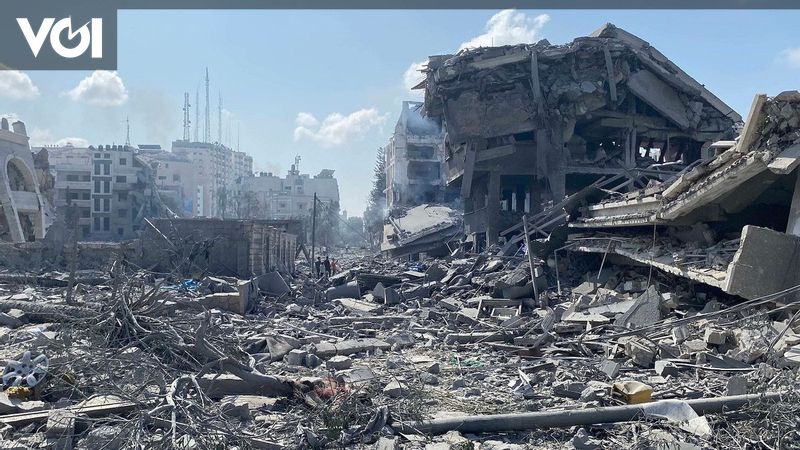JAKARTA – One by one, buckets full of sand and mortar were lifted from the collapsed remains of a museum building in Gaza City. Workers began cleaning a medieval fortress building destroyed by an Israeli military attack on Gaza over the past two years.
A total of 12 workers in transparent jackets worked manually to excavate the remains of the bomb-damaged Pasha Palace Museum building. They pile up rocks that can still be used, while the discarded debris is placed in other piles.
An unmanned Israeli reconnaissance drone or aircraft is operating in the sky of the building where Napoleon Bonaparte stayed in Gaza.
“The Pasha Palace Museum is one of the most significant sites destroyed during the recent war in Gaza City,” said Hamouda Al-Dahdar, a historian and cultural heritage expert in charge of restoration work, quoted by AFP on Friday, November 14.
He added that more than 70 percent of the museum's buildings were destroyed.
As of October 2025, the UN cultural heritage agency UNESCO has identified damage to 114 cultural and cultural sites in Gaza, including the Pasha Palace. Damage has occurred since the Israeli invasion of the Gaza Strip began on October 7, 2023.
Other sites damaged include the Saint Hilarion monastery complex, one of the oldest Christian monasteries in the Middle East, and the Omari Mosque in Gaza City.
Issam Juha, director of the Center for Cultural Heritage Preservation, a nonprofit organization in the Israeli-occupied West Bank that is helping to remotely coordinate the castle's restoration, said the main problem was sourcing materials for the restoration in Gaza.
“There is no more material and we only deal with rubble, collect stones, sort these stones and carry out minimal operations for consolidation,” Juha said.
Israel has imposed strict restrictions on the Gaza Strip since its invasion, resulting in Palestinians in the Gaza Strip lacking various needs, including food and medicine.
After the U.S.-brokered ceasefire agreement took effect in October 2025, aid trucks began pouring in in larger quantities. However, any item crossing the Gaza Strip must be approved through a rigorous review by Israeli authorities, humanitarian organizations said.
Juha said the ceasefire agreement allowed workers to continue their excavations.
Previously, he continued, the work had been unsafe for them and “people were threatened by unmanned aircraft searching the place and shooting.”
Juha said at least 226 cultural and heritage sites were damaged during the war.
He explained that the number of damaged buildings he received was higher than that reported by UNESCO because his team was able to reach more areas in Gaza. He said his organization was loosely affiliated with the Palestinian Authority's Ministry of Antiquities, based in Ramallah.
Dahadar added that his team found 20 important artifacts from the Roman, Byzantine and Islamic periods.
“Our cultural heritage is the identity and memory of the Palestinian people,” Dahadar said in Gaza City.
“Before the war, there were more than 17,000 artifacts in the Pasha Palace, but unfortunately they all disappeared after the invasion of the Old City of Gaza,” he continued.
Gaza's history spans thousands of years, making the tiny Palestinian territories a repository of archaeological artifacts from past civilizations, including Egypt, Persia and Greece.
“We… preserve archaeological stones in preparation for future restoration work, and rescue and extract all artifacts displayed in the Pasha Palace,” Dahdar said.
Along with the ever-growing mountain of excavation rubble, already several meters high, a worker, under the careful guidance of archaeologists, restored a piece of stone decorated with a cross with an Islamic crescent moon.
Another worker carefully cleaned dust from a stone decorated with religious calligraphy.
“We are not just talking about old buildings, but we are dealing with buildings that come from different eras,” Dahdar said.
English, Chinese, Japanese, Arabic and French versions are automatically generated by the AI. Therefore, there may still be inaccuracies in the translation. Please always consider Indonesian as our primary language. (System supported by DigitalSiber.id)
